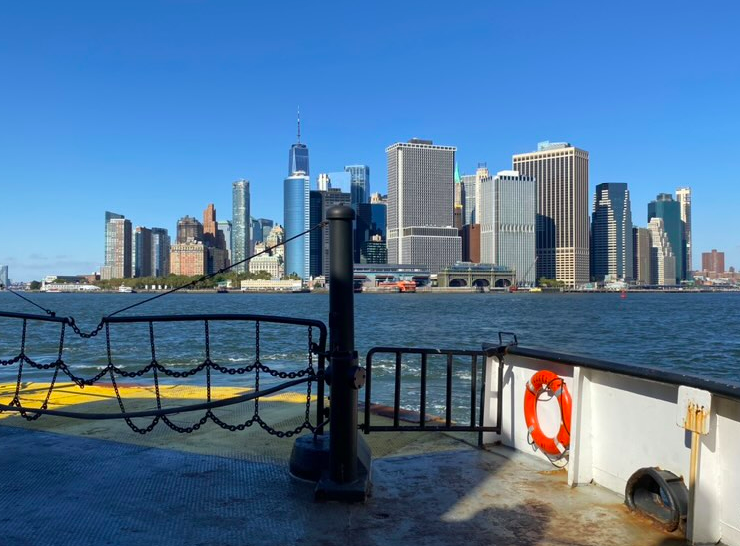The Problem of Invasive Species on Governors Island: Protecting a New York Treasure
How the ‘Friends of Governors Island’ are tackling the issue of invasive species on the island.
Here is the view from the front of the ferry as it exits the Governors Island port. A pristine Manhattan skyline is in full view.
In between Manhattan’s glittering skyline and Brooklyn’s waterfront district, Governors Island is a paradise away from city life. A rich history comes together to form an island of tranquility, diametrically opposed to the hustle and bustle of work done in skyscrapers across the river.
On the ferry boat that leaves on a fixed schedule from the Battery Maritime building, I saw people from all walks of life come together to see for themselves what “downtown’s Central Park” had to offer. The quick seven minute ride couldn’t stop me from asking around: “So why did you go to Governors Island?”
“I hear they have great food, some nice views, and an unmatched spa,” said a traveler on the ferry, Laura DeStabo. DeStabo grew up in Red Hook, Brooklyn and even as a life-long New Yorker, she only found out about Governors Island a little less than a year ago.
“I love biking here, and I’ve known about Governors Island for ages,” said a rushed passerby getting off the port.
Regardless of the reason, it seemed that so many people were taken aback by the majesty of the island’s natural splendor, something that most of the media has failed to cover. Instead, word of mouth has been the fundamental for the island’s publicity, helping to bring in over one million visitors year-round. Its quick rise to fame has led organizations like Earth Matter, The West Harlem Art Fund, and The Public Institute of Architecture to call Governors Island a second home.
Vendors around the city flock to the island’s center of food, Liggett’s Terrace, to showcase ethnic palettes from businesses like Malai, Tokyo Drumstick and Little Evas. Exhibits like the May Room and The American Manifest have led veteran artists to demonstrate how art can connect with both history and humanity, while also offering a place where visitors can feel particularly serene, on an island already filled with a perspective of peace.
The island is not only the place for interesting art and good food, but it is a respectable avenue of respite for families who’ve endured nearly three years of the COVID-19 pandemic.
The opportunities on the island are just as vibrant for fans of monuments and national landmarks. The two forts on the island, along with the yellow houses on Nolan, are ripe for stories, particularly haunted ones that add to the intrigue of Governors Island. During my conversations with Ranger Joe, one of the island’s main gurus of historical stories, he spoke about the particularly gruesome history at Castle Williams.
“Castle Williams was a place where some of the nation’s most feared confederate soldiers were housed. Outbreaks of measles, typhoid and malaria killed prisoners left and right,” said Ranger Joe Korber. Those passionate about supernatural history can find a place in the island’s haunted basketball court in Liggett’s hall or even the apparent ghosts that roam through Fort Jay. These legends add only an additional layer of importance to an island already rich in stories.
On a different note from the historical buildings are the popular attractions that come with the island’s abundance of nature and animal life that spans its 172 acres. The London Plane trees that meld with the Buttermilk Channel are what keep families coming back.
During my conversation with Miranda Williams, a frequent visitor to Governors Island, she spoke graciously of the island’s “junkyard” also known as “The Yard.” It’s in fact the only place in the entire city that can be considered to be an adventure playground. Kids are welcome to explore it, allowing their imagination to give way to their intellectual curiosity.

“My kids have adored it ever since it opened up, and they can’t stop thinking about coming back every other day,” Williams said. Everywhere I went, the praise for Governors Island seemed endless and offered lessons as to why it is our prime job to uphold and protect it.
Right now, Governors Island needs to protect its natural ecosystem and environment as it faces threats on multiple fronts. Its position in the harbor has rendered it susceptible to invasion from species that stow away on docking ships. These organisms pose a threat to the native life that resides year round on the island. One invasive plant species in particular has become a nuisance, and its name resembles that of a Harry Potter-like potion – Mugwort.
Mugwort is a plant that is native to Europe and parts of Asia and Africa, and it is grown in many parts of the world, including North America. Its history is important to traditional systems of medicine in countries such as India and China, and it has been utilized to ward off digestive problems and high blood pressure, amongst other medical issues.
The plant itself arrived on the island through ships, and with the help of a breeze, its seeds had flown into trees that were later planted in Hammock Grove. Mugwort is a single rhizome that grows out of the ground and only occupies the top six inches of the ground into which it is placed, but it chokes out other plants and wildlife.
The plant also alters the composition of soil so that it is not fit for the survival of other plants, and its rapid reproduction rate and fast growth make it hard for its effects to go unnoticed. Mugwort is also able to survive in low quality soil and drought conditions. Without the removal of this plant, it will quickly overtake the plant life of Governors Island, to the detriment of other native species.
Drew Canning, who is the Visitors Services and Intern Programmer for Governors Island, spoke to me regarding the ecological benefits that Governors Island has for countless native species. Her work with the Friends of Governors Island is what keeps this island pristine and perfect for visitors.
“Large birds of prey like falcons and hawks have made this island an important breeding ground prior to heading south for the winter time, while trees like the London Plane and Ginkgo tree have asserted their dominance in the island’s landscape,” Canning said.
However, the island’s horticulture team works together with a team of robust volunteers to weed out Mugwort throughout the summertime when it is most pervasive throughout the island. During the summertime, the island has five sheep named “Evening, Sam, Chad, Phillip Aries, and Flour,” who work to eat the mugwort, helping to reduce the problem of this invasive non-native species.
When asked if the island has considered collaboration with any outside groups to take more drastic measures, Canning said, “that’s where our volunteer recruitment and visitor base come in to help us out, as community outreach is vital to the survival and success of the island.” The team goes by the saying, “if you see Mugwort, pull it.”
However, it is clear that the support of the Friends of Governors Island is vital to the smooth processes that continue every single day on the island. E.B. Kelly, a member of the board of the Friends of Governors Island has described the role of the organization as one that advocates for the island through hosting fundraisers and ensuring that visitors are satisfied with their service.
“We’re truly passionate about what we do, advocacy on behalf of the island, while funding the ongoing horticulture projects is deeply important to our values,” said Kelly. Through Kelly’s oversight and work with the twenty-five member board, all with varying interests and passions, the board of Friends of Governors Island has been able to ensure that the island remains continuously included in the New York City’s budget for funding.
The future of Governors Island is one that will see the development of new avenues of learning and insight. Kelly and Canning are both particularly excited for the development of a new climate center that will become an academic institution at the heart of the island.
“It will be a place where great minds of the world can expand our human horizons while also maintaining this incredible public park,” said Kelly.
Regardless of one’s reason for traveling to Governors Island, something about the evergreen trees and chances for discovery attract so many people from all over New York City, and that is reason enough to protect this unique island, one that so many New Yorkers consider a “home away from home.”
Since opening to the public in 2005, Governors Island has become an integral part of the city. It’s place for school trips and summer camps and one where so many can feel at peace while watching their kids frolic freely or simply by enjoying a delightful snack.
To plan your next trip to Governors Island, click HERE.
In between Manhattan’s glittering skyline and Brooklyn’s waterfront district, Governors Island is a paradise away from city life. A rich history comes together to form an island of tranquility, diametrically opposed to the hustle and bustle of work done in skyscrapers across the river.
Sud Paul is a Features Section Editor for ‘The Science Survey.’ He is interested in journalistic writing because it provides perspective into the duality...











